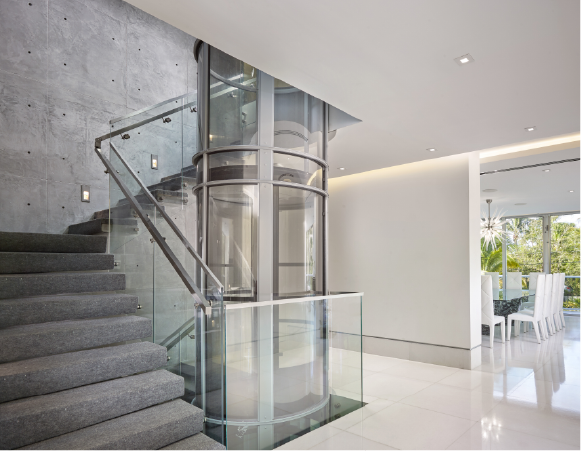As urbanization accelerates in Ghana, homeowners face the dual challenge of maximizing space while ensuring accessibility and aesthetics. With cities expanding rapidly, traditional home designs often fall short in accommodating the needs of all residents, particularly those with mobility challenges. This is where innovative solutions come into play.
Incorporating smart design elements can significantly enhance accessibility without sacrificing style. For instance, open floor plans not only create a sense of spaciousness but also allow for easier movement throughout the home. Additionally, features like ramps that blend seamlessly with architectural designs or multifunctional furniture can optimize limited spaces while maintaining an inviting atmosphere.
Furthermore, technology plays a pivotal role in this evolution. Smart home systems can be integrated to facilitate ease of access through voice-activated controls or mobile apps that manage everything from lighting to door locks. Such advancements ensure that homes are not only beautiful but also functional for everyone.
Ghanaian homeowners have the unique opportunity to lead by example in embracing these innovations. By prioritizing accessibility alongside aesthetic appeal, they can create inclusive living environments that cater to diverse needs while reflecting their personal style and cultural heritage. The future of urban living in Ghana holds promise for those willing to adopt these transformative approaches—proving that functionality and beauty can indeed coexist harmoniously.

Pneumatic elevators are swiftly becoming the go-to choice for homeowners seeking a compact and stylish solution for multi-story living. Unlike traditional elevators, which can be bulky and require extensive renovations, pneumatic elevators utilize air pressure technology to create a sleek, modern lift that seamlessly integrates into any home design.
These innovative systems not only save valuable space but also offer a visually appealing aesthetic that complements contemporary interiors. With their minimal footprint and elegant design, pneumatic elevators provide an efficient means of vertical transportation without compromising on style.
Moreover, the installation process is significantly less invasive than that of conventional elevators, making them ideal for retrofitting into existing homes or incorporating into new builds. Homeowners can enjoy the convenience of easy access to all levels of their residence while enhancing its overall value and appeal. Embracing pneumatic elevators is not just about functionality; it’s about investing in a modern lifestyle that prioritizes both elegance and practicality. Unlike conventional lifts, pneumatic elevators use air pressure to operate, making them energy-efficient, space-saving, and easy to install.
In this guide, we will explore everything you need to know about pneumatic elevators in Ghana, their benefits, costs, and why they are a perfect fit for urban homes.
What Are Pneumatic Elevators?
Pneumatic elevators, also known as vacuum elevators, operate using air pressure differences to move the lift car between floors. These elevators do not require a machine room or counterweights, making them an excellent choice for homes with limited space.
Unlike hydraulic or traction elevators, pneumatic lifts rely on a vacuum system to create suction, lifting the car upwards, while controlled air release allows for a smooth descent.
Why Pneumatic Elevators Are Gaining Popularity in Ghana
The demand for space-efficient and stylish home solutions is growing in Ghana. Here’s why many homeowners are opting for pneumatic elevators:
- Minimal Structural Modifications: No need for a pit or machine room.
- Quick Installation: Can be installed within a few days.
- Energy Efficiency: Uses minimal electricity compared to traditional lifts.
- Sleek and Modern Design: Enhances the aesthetic appeal of homes.
- Safe and Reliable: Equipped with emergency braking systems and battery backup.
Why Pneumatic Elevators Are Perfect for Urban Homes in Ghana
Why Pneumatic Elevators Are Perfect for Urban Homes in Ghana Urban homes in Ghana, especially in Accra and Kumasi, face challenges such as limited space and high construction costs. Pneumatic elevators provide a space-efficient solution while adding a touch of modern luxury. They are particularly beneficial for:
- Small to Medium-Sized Homes: Ideal for townhouses and duplexes.
- Elderly and Mobility-Impaired Residents: Provides a convenient and safe way to navigate floors.
- Luxury Homes and Villas: Enhances property value and design appeal.
Types of Pneumatic Elevators Available in Ghana
1. Single-Passenger Pneumatic Elevators
These compact elevators accommodate one person at a time, making them ideal for homes with minimal space.
2. Two-Passenger Pneumatic Elevators
Slightly larger, these elevators allow two people to travel together comfortably.
3. Wheelchair-Accessible Pneumatic Elevators
Designed to accommodate wheelchairs, these models provide an accessible mobility solution for individuals with disabilities.
The Cost of Pneumatic Elevators in Ghana: A Detailed Breakdown
The Cost of Pneumatic Elevators in Ghana: A Detailed Breakdown One of the biggest questions homeowners have is how much a pneumatic elevator costs. While prices vary depending on the model, installation, and customization options, here’s a general breakdown:
| Elevator Type | Estimated Cost (GHS) |
|---|---|
| Single-Passenger Pneumatic Elevator | GHS 450,000 – 500,000 |
| Two-Passenger Pneumatic Elevator | GHS 550,000 – 600,000 |
| Wheelchair-Accessible Pneumatic Elevator | GHS 640,000 – 700,000 |
Factors Affecting the Cost
- Number of Floors: More floors require additional customization.
- Installation Complexity: Some homes may need minor modifications.
- Customization Options: Special finishes, colors, and features can increase costs.
- Maintenance Costs: Though minimal, regular servicing ensures longevity.

Space-Saving Elevator Solutions: Is a Pneumatic Elevator Right for You?
Space-Saving Elevator Solutions: Is a Pneumatic Elevator Right for You? If you’re considering a pneumatic elevator for your home, ask yourself the following:
- Do you have limited space but still need an elevator?
- Are you looking for a modern, stylish alternative to traditional lifts?
- Do you need an energy-efficient and low-maintenance solution?
- Would you like to increase the value of your home while improving accessibility?
If you answered yes to most of these questions, a pneumatic elevator might be the perfect solution for your Ghanaian home.
Installation and Maintenance of Pneumatic Elevators in Ghana
One of the biggest advantages of pneumatic elevators is their ease of installation. Unlike traditional lifts, they do not require extensive construction work, making them ideal for existing homes. Installation typically involves:
- Site Inspection – Evaluating space and structural requirements.
- Customization & Ordering – Choosing the appropriate model and design.
- Installation – Usually completed within 2-3 days.
- Testing & Safety Checks – Ensuring the elevator operates smoothly and safely.
Maintenance Tips
- Regular Cleaning: Keep the transparent tube and interior clean.
- Annual Inspection: Check vacuum seals and air pressure systems.
- Emergency Backup System Checks: Ensure battery backup functions properly.
Conclusion
Pneumatic elevators offer a modern, space-saving, and stylish solution for homeowners in Ghana. Their ease of installation, energy efficiency, and minimal maintenance make them an excellent choice for urban homes. Whether you’re looking to enhance accessibility, add luxury, or improve your home’s resale value, pneumatic lifts are a smart investment.
For more insights on pneumatic elevators, check out:
- Why Pneumatic Elevators Are Perfect for Urban Homes in Ghana
- The Cost of Pneumatic Elevators in Ghana: A Detailed Breakdown
- Space-Saving Elevator Solutions: Is a Pneumatic Elevator Right for You?
With the increasing demand for modern home solutions in Ghana, pneumatic elevators are becoming the preferred lift choice for those seeking style, functionality, and convenience.

